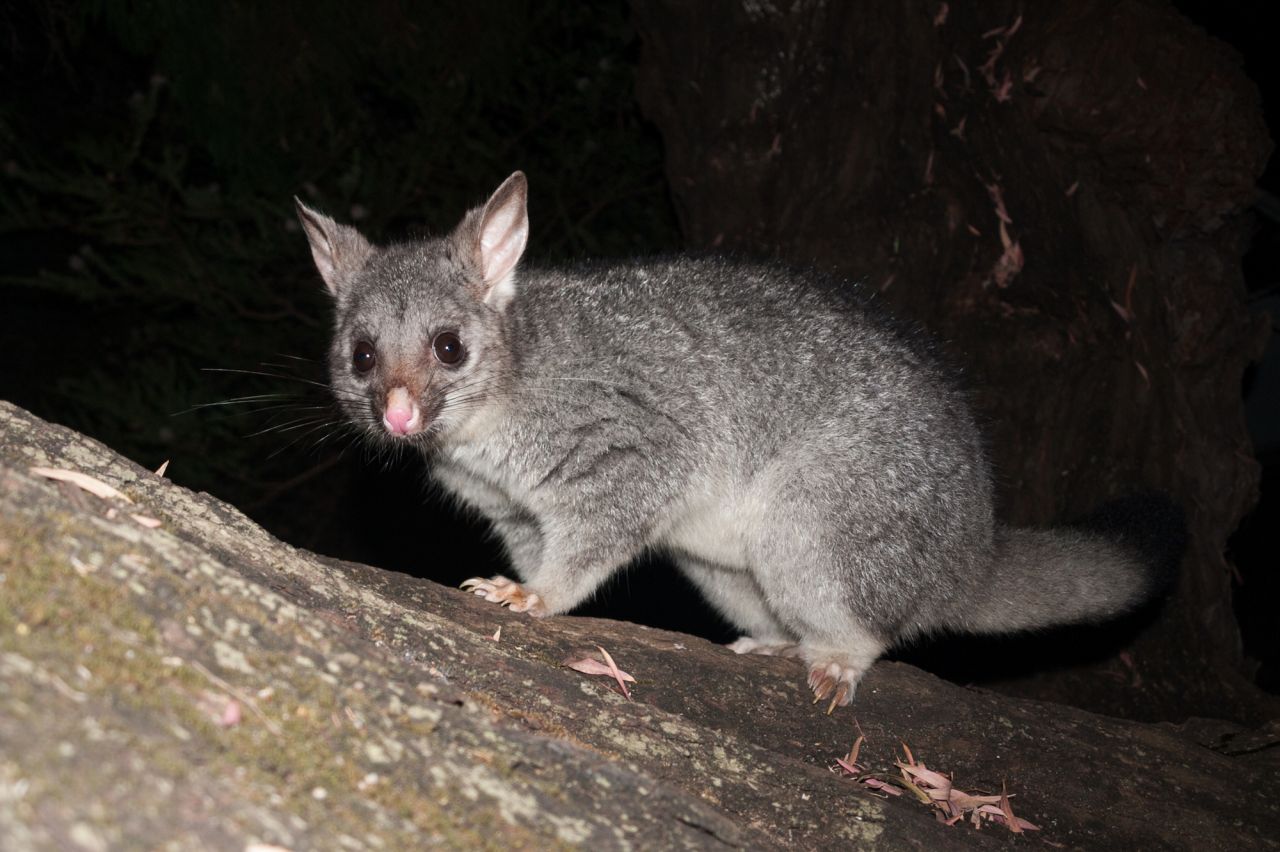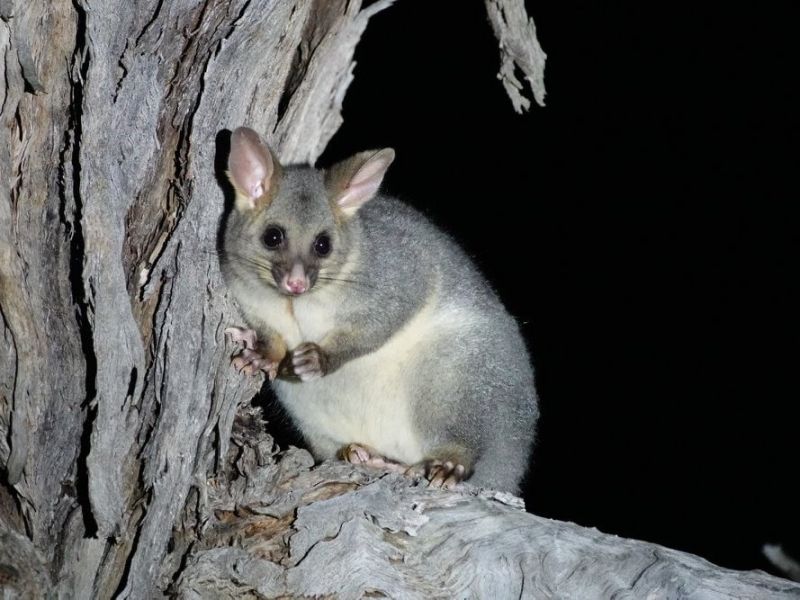Few Australian animals are as familiar (or as divisive!) as the Common Brushtail Possum (Trichosurus vulpecula). This adaptable marsupial has become a fixture of both bushland and suburbia, equally at home in towering eucalypt forests or the rafters of a backyard shed. For some, it is a delightful visitor, a reminder of native wildlife living among us. For others, its heavy footsteps in the roof and appetite for fruit trees make it an unwelcome housemate. Despite these differences, the brushtail plays an important ecological role, from dispersing seeds to shaping vegetation communities, and is one of the most successful native mammals in Australia.
Size & Appearance
Brushtail possums are medium-sized marsupials, usually measuring 35–55 cm in body length, with a thick, bushy tail almost as long again. Adults weigh between 1.2 and 4.5 kg, with males typically larger than females. Their dense coat ranges in colour from silver-grey to reddish-brown or black, depending on region and habitat, while Tasmanian individuals are often larger and darker. The large, bright eyes are adapted for night vision, and the long whiskered snout provides an excellent sense of smell. Their strong limbs, sharp claws, and prehensile tail make them agile climbers, perfectly suited to an arboreal lifestyle.
Behaviour & Diet
Brushtails are nocturnal and spend daylight hours resting in dens—tree hollows, burrows, or human-made shelters such as roof spaces. At night they emerge to feed, following a predominantly herbivorous diet. Leaves, flowers, fruits, and bark make up the bulk of their food, but they are remarkably flexible, sometimes eating fungi or small invertebrates. In urban settings, they readily exploit fruit trees, vegetable gardens, and even scraps of human food.
Ecologically, brushtails are important seed dispersers and occasional pollinators, helping regenerate forests and woodlands. Their browsing also influences plant growth, sometimes creating tension in conservation areas where they feed heavily on particular species.

Nocturnal spotting in the Southern Highlands. Image: Sydney Bespoke Tours
Breeding & Life Cycle
Breeding occurs mainly in autumn and spring, although in favourable conditions females may breed year-round. After a very short gestation of around 17 days, a tiny, underdeveloped joey crawls into its mother's pouch, where it attaches to a teat and continues developing. The joey remains in the pouch for about four months before gradually emerging to ride on its mother's back. Weaning occurs at around six months, but young may stay with their mother for several more months.
Brushtails are one of the marsupials that exhibit embryonic diapause - a reproductive adaptation that allows females to delay the development of a fertilised egg until the pouch is available again. This ensures they can maximise breeding success when resources are plentiful. In the wild, brushtails typically live 6–7 years, though in urban environments with fewer predators, some survive over a decade.
Conservation & Threats
The Common Brushtail Possum is listed as Least Concern in Australia, thanks to its adaptability to both natural and urban environments. However, local populations can face pressures from vehicle collisions, predation by cats and dogs, habitat loss, and illegal poisoning when individuals take up residence in homes.
Historically, brushtails were hunted extensively for the fur trade, with millions taken during the 19th and early 20th centuries. While no longer exploited in this way in Australia, their introduction to New Zealand in the 19th century has had devastating consequences. Without natural predators, they have become a major invasive pest there, causing severe damage to forests and threatening native bird species.

Common Brushtail Possum spotted on a nocturnal walk in the Riverland. Image: Murray River Trails
Where to see Common Brushtail Possums in the wild
In Australia, brushtail possums are widespread and relatively easy to observe. They are common in woodlands, eucalypt forests, and urban parks across the mainland and Tasmania. In cities, they can often be spotted after dark along powerlines, in suburban gardens, or raiding fruit trees.
Some of the best places to see them include:
Southern Highlands (Sydney), New South Wales
Suggested Southern Highlands tours:
- Sydney Wildlife Safari (Full Day) - Sydney Bespoke Tours
Maria Island, Tasmania
Suggested Maria Island tours:
- The Maria Island Walk (4 Days) - The Maria Island Walk
- Tasmanian Wildlife Encounter (5 Days) - Premier Travel Tasmania
Cradle Mountain, Tasmania
Suggested Cradle Mountain tours:
- Western Wilderness & Wildlife Encounter (9 Days) - Premier Travel Tasmania
- Tasmania's Western Wilderness (5 Days) - Premier Travel Tasmania
Riverland, South Australia
Suggested Riverland tours:
- Murray River Safari (4 Days) - Murray River Trails
- Murray River Walk (4 Days) - Murray River Trails
Kangaroo Island, South Australia
Suggested Kangaroo Island tours:
- Kangaroo Island In Style (2 Days) - Exceptional Kangaroo Island
- Kangaroo Island Wildlife Photography Tour (3 Days) - Exceptional Kangaroo Island
FAQs
Are Common Brushtail Possums dangerous?
No. They are shy, non-aggressive animals and usually avoid contact with people. They may scratch or bite if cornered, so should never be handled without professional training.
Why do Common Brushtail Possums make such loud noises?
They are highly vocal animals, producing screeches, hisses, grunts, and growls to communicate. These sounds are often territorial, warning rivals to stay away.
Do Common Brushtail Possums damage houses?
Yes, they sometimes nest in roof cavities, leaving droppings and chewing timbers or wires. The humane solution is to seal roof access points and provide a nest box nearby to encourage relocation.
How long do Common Brushtail Possums live for?
In the wild, brushtails average 6–7 years, though in urban areas where food is plentiful and predators fewer, individuals may reach 10–12 years.

